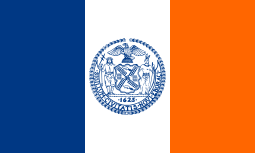Hoe Avenue peace meeting
The Hoe Avenue Peace Meeting was an important gathering of New York City gangs on December 7,[1] or December 8, 1971,[2][3] (sources vary) in the Bronx. It was called to propose a general truce and an unprecedented inter-gang alliance. The impetus for the meeting was the murder of "Black Benjie", a peace keeper of the Ghetto Brothers. While no lasting peace was ever established, a subsequent negotiation established a procedure for dealing with conflicts to avoid street "warfare". The meeting is notable as one of the first attempts by street organizations to broker a truce between groups of different ethnic backgrounds.
History
The meeting was held at the Boys Club on Hoe Avenue in the Bronx with dozens of street organizations and many city officials and police present. Present at the Hoe Avenue peace meeting included the Black Pearls, Savage Skulls, Turbans, Young Sinners, Royal Javelins, Dutchmen, Magnificent Seven, Dirty Dozens, Liberated Panthers, Black Spades, Seven Immortals, Latin Spades, Peacemakers and the Ghetto Brothers.[4] The peace meeting was organized by the Ghetto Brothers after one of their members, 25-year-old Cornell "Black Benjie" Benjamin, was killed trying to stop a gang fight.[5][6] The objective was to draw up a peace treaty in honor of "Black Benjie", who had been the designated peacemaker of the Ghetto Brothers.
To help ensure it would be nonviolent, it was arranged to have a member of the Turbans gang to take position, with a rifle, on a rooftop across the street from the Boys' Club on the day of the meeting.[7] Inside, the power structure was in evidence. Presidents, vice-presidents, and warlords sat on folding chairs in a circle in the middle of the club's gymnasium. Gang members took seats in the bleachers, while wives were made to wait outside the building. Only two females were permitted inside—the presidents of the all-girl gangs, the Alley Cats and the Savage Sisters—and their folding chairs were placed in the last/fourth row, behind those of the warlords.[8] The Peace Meeting appears in Flyin' Cut Sleeves, a documentary film by Rita Fecher and Henry Chalfant (completed 1993, released 2009)[9]
Spanish Eddie
One of the Youth Services Agency's Bronx gang crisis squad, Eduardo Vincenti, 27, "Spanish Eddie" (a veteran of the 1950s Bronx street gangs), began working on the grandiose notion of getting every major gang in the Bronx to sign an intergang treaty and alliance.[10] This giant alliance would be called "The Family", and every gang would become a division in the larger gang. The idea had just enough vision in it for gang leaders to be interested in its possibilities. Vincenti felt that once unified under a single name, the gangs could do virtually anything, if someone provided them with the right kind of social vision. The police admitted to as many as 10,000 gang members in the Bronx alone.[11]
Vincenti signed on 68 gangs to the coalition/treaty before he and 10 other crisis squad members were suddenly transferred from the Bronx and reassigned to Brooklyn where he was shot in the face trying to prevent a gun battle in the West Farms neighborhood.[4] Vincenti survived to continue work on the Brotherhood Family in his spare time. Bronx Squad Crisis members believed the shooting was orchestrated in response to Spanish Eddie's attempts to broker a treaty.[4]
40th anniversary
In 2011, former members of the Ghetto Brothers & Black Panthers spoke to the New York Daily News in advance of a planned commemoration scheduled to take place at the Bronx River Art Center, 305 East 140th Street. Joseph Mpa of the Black Panthers stated that the truce itself played a role in the rise of hip hop culture since it permitted greater ease of travel between neighborhoods without fear of reprisals for crossing gang boundaries.[3]
See also
-
 New York City portal
New York City portal - Watts Truce
- Rubble Kings - 2015 documentary that depicts events preceding and following the Hoe Avenue Peace Meeting
References
- ↑ Clark, Ramsey (1974). Crime and Justice. Arno Press. p. 192. ISBN 0-405-04167-5.
- ↑ Rubble Kings. Saboteur Media documentary; director Shan Nicholson. 2015. Event occurs at 40:54.
- 1 2 Samuels, Tanyanika (December 8, 2011). "Former Bronx gang members mark 40th anniversary of truce that led to decline of street violence in the 1970s". Daily News. New York City. Archived from the original on February 22, 2015. Retrieved October 14, 2013.
- 1 2 3 Lewis, Miles Marshall; Williams, Saul (2005). Scars of the Soul Are Why Kids Wear Bandages When They Don't Have Bruises. Akashic Books. pp. 87–93. ISBN 1-888451-71-8.
- ↑ Schneider, Eric C. (1999). Vampires, Dragons, and Egyptian Kings. Princeton University Press. p. 243. ISBN 0-691-07454-2.
- ↑ Reaper, pp. 96, 93
- ↑ Sources: The Compound, p. 88; and Vampires, last chapter
- ↑ The Compound, pp. 88-89
- ↑ Frere-Jones, Sasha (August 20, 2009). "Flyin' Cut Sleeves". Archived from the original on June 18, 2015. Retrieved June 18, 2015.
- ↑ Can't Stop, Won't Stop: A History of the Hip-hop Generation By Jeff Chang, D.J. Kool Herc Page 55 Published 2005 Macmillan ISBN 0-312-42579-1
- ↑ Reaper, p. 93